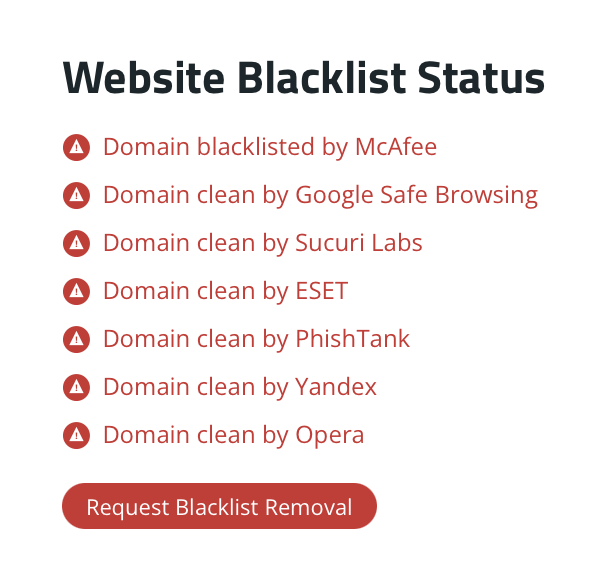Running an online business, comes with its ups and down. But nothing is more worrying than an issue with the site’s stable functionality and security. When you suddenly discover that your website has been hacked and blacklisted by all the major systems panic sets in – what do you do now? Don’t worry, we’ve got you covered. In this post, we’ll outline the steps you need to take to get your website back up and running.
Step 1: Acknowledge the Problem
Like everything in life, acknowledging the problem is the first step in overcoming it. A compromised system is no joke. For a functioning system that equals lost revenue, lost authority and trust, and countless hours of work that needs to be done to regain lost ground.
Don’t ignore the issue or try to cover it up – the longer you wait, the more damage it can cause. Admit that there’s a problem and take action.
Step 2: Assess the Damage
Determine the extent of the damage by evaluating what type of hack was used to compromise your website. This will help you identify the next steps you need to take to resolve the issue.
There are several different types of hacks that can compromise a website, including:
- SQL Injection: This is a type of hack where an attacker injects malicious SQL code into a web page, which can be used to extract sensitive data or take control of the website.
- Cross-Site Scripting (XSS): This type of hack involves injecting malicious code into a website’s code, which can then be executed by unsuspecting visitors to the site.
- DDoS Attacks: These attacks overwhelm a website with traffic, effectively shutting it down and making it inaccessible to visitors.
- Malware: This is any software that is designed to damage or disrupt a website’s functionality or steal sensitive information from users.
Step 3: Take Your Website Offline
It’s important to take your website offline to prevent further damage and to avoid infecting other visitors’ devices. It may be difficult to do this, but it’s necessary to prevent the situation from worsening.
To take your website offline, you can use one of the following methods:
- Disable your website: You can disable your website by taking it offline from your web hosting control panel. This method is quick and easy, but it may not be the most effective, as the hacker may still be able to access your files and data.
- Take your server offline: Another method is to take your server offline. This involves physically shutting down the server that hosts your website. This method is more effective than disabling your website, as it prevents the hacker from accessing your files and data.
- Use a firewall: If you have a firewall installed on your website, you can use it to block traffic to your website. This will prevent visitors from accessing your site and protect them from being infected with malware.
- Create a temporary HTML landing page: Another option is to create a temporary HTML landing page with a message for your users. This will let them know that your website is temporarily unavailable and that you’re working to resolve the issue. You can also provide them with alternative ways to contact you, such as email or phone.
Once your website is offline, you can begin the process of removing the malware and fixing the issue that caused the hack. Remember to keep your visitors informed about the situation and let them know when your website will be back online.
Step 4: Remove the Malware
Identify the type of hack that was used and remove the malware that caused the issue. Here is a separate guide on malware removal. To see more details on the malware you can use security scanning tool like http://sitecheck.sucuri.net or you can get in touch with us and we’d be happy to help.
Step 5: Change All Passwords
Change all login credentials and passwords associated with your website, hosting account, and any other third-party services that may have been compromised. Make sure that all passwords are strong and complex.
Step 6: Install Updates and Patches
Make sure that all software, plugins, and other components of your website are up-to-date and that all security patches have been installed. This will help prevent similar hacks in the future.
Step 7: Request a Review
Contact the relevant blacklist authorities, such as McAfee, Google Safe Browsing (you will have to create an account in Google Search Console), etc. and request a review of your website once you’ve resolved the issue. This can take some time, but it’s an important step to ensure that your website is no longer blacklisted.
Step 8: Monitor Your Website
Keep a close eye on your website to ensure that the issue has been completely resolved and that there are no further signs of malicious activity. You may want to use a security plugin to monitor your site on an ongoing basis.
Step 9: Implement Preventative Measures
Take proactive steps to prevent future hacks, such as using strong passwords, updating software regularly, and implementing security measures such as firewalls and antivirus software.
Step 10: Inform Your Users
If your website has been compromised, it’s important to let your users know what steps you’ve taken to resolve the issue and what they can do to protect themselves. Be transparent and honest – this will help rebuild trust with your users.
Getting hacked and blacklisted is a scary experience, but it’s not the end of the world. By following these steps, you can get your website back up and running and prevent similar hacks from happening in the future. Remember, prevention is key – take proactive measures to protect your website and your business.
One way to ensure that your website is always up-to-date, secure, monitored, and backed up is by enlisting the help of a professional support and maintenance service. We offer a comprehensive support and maintenance service that not only updates your website to the latest software but also monitors it for any suspicious activity and backs it up to prevent data loss. In the rare event that your website does get hacked and blacklisted, our team will implement the necessary clean-up and delisting at no extra cost. With our support and maintenance service, you can have peace of mind knowing that your website is always running smoothly and securely.
Don’t wait until it’s too late – contact us today to learn more about our support and maintenance service and how we can help protect your website from hackers and other security threats.

